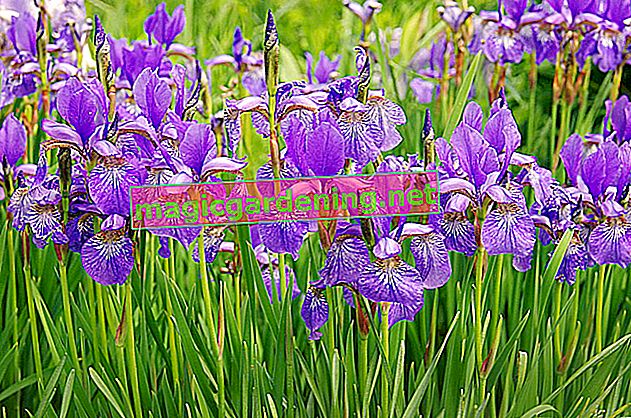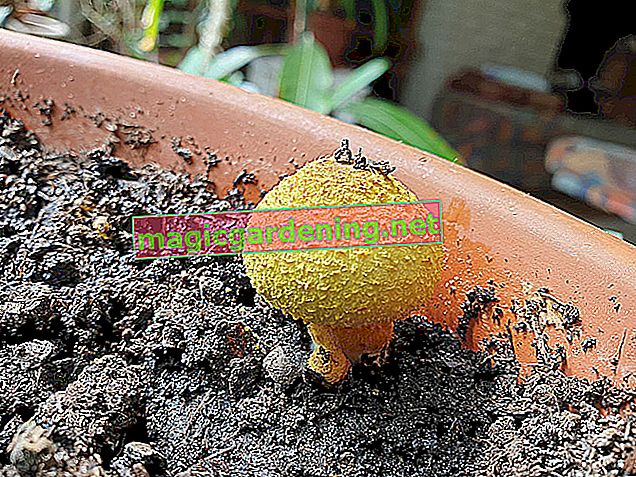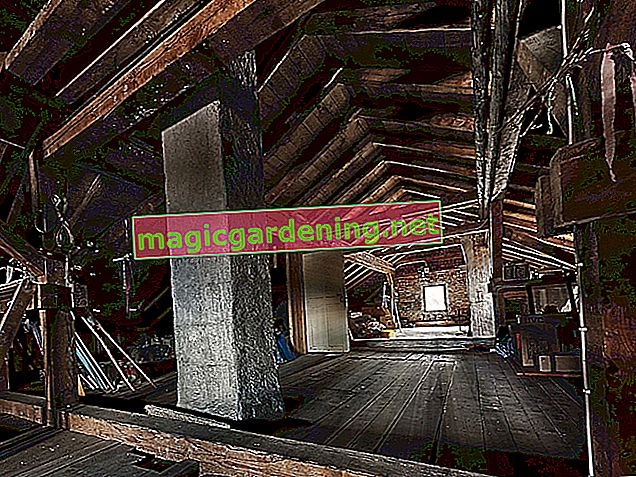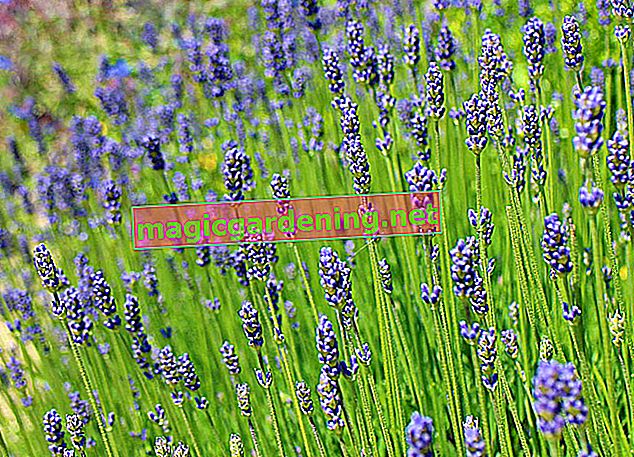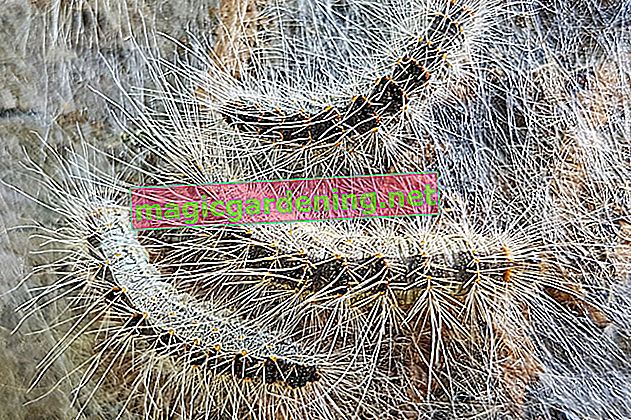
origin
Milky stars belong to the genus Ornithogalum. The bulb plants with the underground survival organs occur with some species in Europe. Their distribution area extends into northern Africa. Milky stars are also found in the tropical regions of Africa and Asia. The asparagus species grow in meadows, on embankments and on moist soil in forests.
also read
- Caring for ornithogalum (milk star) properly - tips for care
- Caution: the Milky Star is unfortunately poisonous!
- Hibernate the Milky Star properly
Useful information:
- Milky stars are known under the name of Gärtnerschreck
- Use in Bach flower medicine as a soul balm
- Ornithogalum means bird's milk
blossom
Milky stars develop racemose inflorescences that are composed of at least two individual flowers. Each flower has membranous bracts at the base. The single flowers are constructed with radial symmetry and threefold. They have six bracts that are designed the same. They shine in a pure white and have a yellowish to green colored stripe on their underside. One species develops orange flowers.
The flowers open when exposed to direct sunlight. They are reminiscent of twinkling stars in the night sky, which is what gave the plants their German name. The flowering time for indoor plants begins in February and continues into September. Outdoor plants bloom later. If you dig the bulbs out of the ground in autumn and put them in a pot, the plant will again receive incentives for a growth spurt. Just in time for Christmas the plants develop new flowers.
leaves
As monocot plants, milk stars develop grass-like leaves. They grow at the base and are elongated. There are species with smooth leaf margins and those in which the leaves are hairy on the edge. In all species the leaves appear fleshy. Some of the leaves have a silvery stripe.
growth
Milky stars are geophytes that grow as perennial herbaceous plants. They develop onions that serve as persistence organs. In autumn, the plants pull the nutrients from the above-ground parts of the plant and store them in the bulb. The plants spend mild winters in the ground. They use the stored energy to germinate in spring. Most milk stars reach heights of between 25 and 30 centimeters. Some species grow up to 40 centimeters or occasionally up to a meter high.
use
Milk stars can be planted outdoors as well as cultivated in pots. They are suitable for underplanting sparse trees. In the vicinity of other onion plants, milk stars provide colorful accents in the spring bed. Hardy species look good in partially shaded rock gardens. The varieties of Ornithogalum thyrsoides are suitable as cut flowers.
Here the Milky Star convinces:
- in summer discounts
- at the edges of beds and lawns
- under wood arrangements
Is Milky Star Poisonous?
All parts of the milk star plant contain cardenolides. The concentration is highest in the onions. These chemical compounds are among the steroids that affect the heart. Milky stars carry the chemically active substances in the form of glycosides in the organism. Consumption leads to stomach and intestinal problems, nausea and vomiting. Headache may occur. High doses can lead to cardiac arrhythmias. The milk juice can cause irritation on contact with the skin. There is a high risk of poisoning in cats and dogs.
Continue reading
What soil does the plant need?
A loose substrate offers permeable conditions from which milk stars benefit. They prefer fresh soil, because the bulbous plants are sensitive to conditions that are too wet. A high proportion of nitrogen ensures vigorous growth and high vitality. Standard soil that is tailored to the requirements of hyacinths is suitable for the cultivation of plants. Mix the substrate with sand to improve the soil structure for the milk star. The bulb plants tolerate lime-containing conditions in the substrate, but they prefer a low-lime environment.
Suitable substrate:
- sandy, clay and gravel
- Mixture of potting soil with sand and pumice gravel
- Clay granules as an alternative to sand
- Cactus soil
Which location is suitable?
Milky stars prefer a warm location that can also lie in the sun. They thrive ideally in partially shaded places. Temperatures between 15 and 20 degrees Celsius provide the onion plants with optimal growth conditions. Higher temperatures are not a problem for the herbaceous plants.
If you cultivate milk stars in a pot, a bright and warm place on the windowsill is ideal. You can also put the plant in the conservatory or plant it in a greenhouse. If you cultivate the Milky Stars as houseplants, direct sunlight should be avoided. During the summer months you can put the bucket in a sheltered and warm place outdoors.
What is the best time to plant?
If you plan to plant frost-sensitive species, you should wait until spring. Late frosts can damage the onions. Repotting should also take place in spring. Hardy species can be planted ready in autumn. If you want to sow seeds, you don't have to be guided by the seasons as much. Sowing is possible in autumn or spring.
The correct planting distance
The minimum distance to the next planting partner should not be less than 15 centimeters. A planting distance of 20 centimeters is ideal. In cramped conditions, there is a risk that the milk stars will not sprout. When planting the bulbs, pay attention to the depth of the soil. Milk star bulbs should be inserted ten centimeters into the substrate.
Propagate Milky Star
Every two to three years you can divide clumps that have grown too close and multiply in this way. Dig up the bulbs completely after the flowers wilt. With a sharp knife, you can cut the bulbs into several small pieces and plant them again.
Propagation using seeds you have collected yourself is possible. The development of seeds requires successful insect fertilization. Once the plant has finished flowering, remove the seeds from the flowers. Scatter the seeds on a moist and nutrient-poor substrate. Bird sand, pumice gravel or potting soil are ideal. Make sure that the seeds are not covered by the substrate.
The light germs need a bright and warm location with temperatures of at least 20 degrees Celsius. Keep the substrate evenly moist by spraying. Germination begins after about two weeks.
Milky star in the pot
Milky stars are suitable for cultivation in the bucket. The houseplants can be cared for in pots all year round so that the plants do not go into hibernation. With this cultivation, keep in mind that milk stars lose their vigor over time. The winter rest also serves for regeneration.
Container plants need to be repotted regularly. This is the case when the nutrients in the soil have been used up or the plant has developed daughter tubers. This measure takes place immediately after the resting phase in spring. In the case of potted plants that do not go into hibernation, repotting takes place before the flowering period.
How to repot milk stars:
- Dig up the onions and remove all of the soil
- Separate or snap off the onions with a sharp knife
- Place onions in fresh soil and cover lightly
Pour the Milky Star
Do not water the bulbs immediately after planting or repotting. Wait until the plant has sprouted before watering it for the first time. As soon as the first green shoots come out of the earth, you can start watering. Once the plants have grown, they will need moderate amounts of water during the growth phase.
Make sure that the substrate is evenly moist but not too wet. Most of the time, the spring and summer rainfall water is enough to meet the water demand. You should only water the bulb plants in addition during long periods of drought. Soak the soil copiously with water instead of providing it with small amounts of water several times. In autumn you can slowly reduce the watering.
Water potted plants when the substrate has dried on the surface. Make sure that no water remains in the coaster. Waterlogging causes the roots to rot. Indoor plants need water even in winter. Onions that you overwinter in the cellar do not need to be watered.
Fertilize milk star properly
Milky stars have moderate nutritional requirements. They need nitrogen and enjoy fertilization in the field that is repeated every 14 days to four weeks. You can orientate yourself on this period of time, but you should pay attention to the nature of the soil with the frequency of fertilization. Nitrogen-based fertilizers are suitable as a source of nutrients when they are heavily diluted with water. A nitrogen concentration of 0.1 percent is ideal. Use the fertilizer sparingly. In winter you do not need to fertilize the stored onions and potted plants.
Cut the milk star correctly
You can cut back the foliage in autumn. As soon as the plant has completely died, you should remove the plant parts so that they do not rot on the bed. Cut the plant material close to the ground with sharp secateurs. Alternatively, you can remove the yellow leaves from the base of the leaves with a gentle pull. With this method, the leaves should be completely withered, otherwise you could damage the bulb.
Many species are suitable as cut plants. Cut off the flower stems just before the flowers open and place the cut flowers in a vase.
How do I transplant properly?
Milk stars that are grown in pots should be transplanted every spring. With this measure, the nutrient content of the soil is improved and you save additional fertilizer over the year. Outdoor plants only need to be replanted or thinned if the stands are too dense.
Withered
When milk stars fade, the leaves slowly begin to wither. The plant draws the excess energy from the above-ground parts of the plant and stores it in the bulb. Therefore, you should not cut back the plants immediately after flowering. This means that there is a risk that the plants cannot store enough nutrients. These energy reserves are lacking next spring and they cannot sprout.
Continue reading
Overwinter
Most milk stars do not survive the frosty temperatures of the winter months in Central Europe unscathed. They are adapted to mild winter temperatures. In the fall, dig the bulbs out of the ground and store the tubers in a dry and cool place in the basement. Temperatures of ten degrees Celsius are ideal. Dry conditions are necessary so that no putrefaction processes occur. If the air is too dry, you should carefully spray the onions with water to avoid drying out.
The dead plant parts can be cut off and composted. There are hardy species that can be left in the bed even in winter. Make sure that the earth does not get wet in winter. Moisture causes the onions to rot in the ground and not sprout again in the next spring.
Continue reading
Diseases
Milky stars show themselves to be insensitive to diseases and pests. In the summer months, aphids can occasionally be attacked. Removing the pests with a sharp jet of water has proven to be an effective control measure. Only wrong care measures can affect its vitality. The most common problem is root rot, which is caused by waterlogging.
Yellow leaves
In autumn, the leaves of the milk stars wither, turning them yellow. At this time of year, there is no need to worry as this process signals the beginning of the resting phase. If the onion plants get yellow leaves in the open ground, root rot is a possible cause. Check the onions to rule out damage from waterlogging. Caution is advised with houseplants that suddenly turn yellow leaves. Here you should make sure that no water remains in the coaster.
Milky star does not bloom
Older milk stars become blooming after a few years in the field. They develop fewer flowers because the distance between plants is reduced in wild-growing stands. The plants need at least 20 centimeters to the next plant so that they can develop unhindered. Dig up the bulbs and place the tubers in the ground at a greater distance. Remove side onions, as these will weaken the main onion even more. As part of this maintenance measure, you can remove dried leaves.
Tips
Milky stars bloom in their natural range from autumn to spring. In the species cultivated outdoors, the flowering phase shifts. It makes more sense to cultivate the milk star as a houseplant. A plant lamp is recommended in winter to promote the natural flowering times.
sorts
- Ornithogalum montanum: Frost-hard milk star with large abundance of flowers. Growth height up to 20 centimeters.
- Ornithogalum umbellatum: Green leaves with white vertical stripes. Flowers white with green stripes. Flowering time between April and May.
- Ornithogalum nutans: White-silvery star flower. Flowering time between May and June. Single flowers with long stalks. Reminiscent of a miniature lily. Grows to 40 centimeters high. Frostproof
- Ornithogalum arabicum: flowers up to five centimeters in size. Ovary blue-violet. Recommended as a houseplant.
- Ornithogalum dubium: Blooms between June and August with orange flowers. Recommended as a houseplant.
- Ornithogalum saundersiae: flower stalks up to 100 centimeters long. Suitable for spring bouquets.


